Question
Part i A worker is selected at random. What is the probability that he lives in an urban area given that he drives to works?

Part i A worker is selected at random. What is the probability that he lives in an urban area given that he drives to works?
? A. 600/1300 ? B. 450/600 ? C. 450/1100 ? D. 450/1300
Part ii Which of the following statements is true?
? A. Mode of transportation and residence are dependent, but they would be independent if we changed the second row of counts from 650, 50, 700 to 475, 225, 700.
? B. Mode of transportation and residence are dependent, but they would be independent if we changed the second row of counts from 650, 50, 700 to 650, 650, 1300.
? C. Mode of transportation and residence are dependent, but they would be independent if we changed the second row of counts from 650, 50, 700 to 550, 150, 700.
? D. Mode of transportation and residence are dependent, but they would be independent if we changed the second row of counts from 650, 50, 700 to 450, 250, 700.
? E. Mode of transportation and residence are dependent, but they would be independent if we changed the second row of counts from 650, 50, 700 to 525, 175, 700.
? F. Mode of transportation and residence are independent.
Part iii To encourage people to take public transit, the government runs a program which provides free transit passes for a month. The 600 residents who drive to work are invited to participate in the following experiment. Half of the urban residents who drive to work are randomized to receive the free pass for one month and half do not receive such free pass. The rural residents who drive to work are randomized in a similar fashion. After six months, the proportion of urban residents who switch to taking public transit is compared between the free-pass and no-free pass groups. The same comparison is also done among the rural residents. In the experiment described above, area of residence (urban versus rural) [CHECK ALL THAT APPLY]
? A. defines the treatments.
? B. is the blocking variable.
? C. defines the experimental units.
? D. is the response variable.
? E. none of the above.
Part iv What is the purpose of performing the treatment randomization and comparison for the urban and rural residents separately? Choose the most appropriate answer.
? A. To evaluate the effect of area of residence on the residents' willingness to switch to taking public transit.
? B. To ensure that both urban and rural residents can participate in the study.
? C. To control for the effect of area of residence on the residents' willingness to switch to taking public transit.
Part v To display the data for the two variables: area of residence and whether residents switch to taking public transit after six months, what is the most appropriate display to use?
A. A scatterplot. ? B. Side-by-side boxplots. ? C. A stem-and-leaf display. ? D. A contingency table. ? E. A histogram

Step by Step Solution
There are 3 Steps involved in it
Step: 1

Get Instant Access to Expert-Tailored Solutions
See step-by-step solutions with expert insights and AI powered tools for academic success
Step: 2

Step: 3

Ace Your Homework with AI
Get the answers you need in no time with our AI-driven, step-by-step assistance
Get Started


